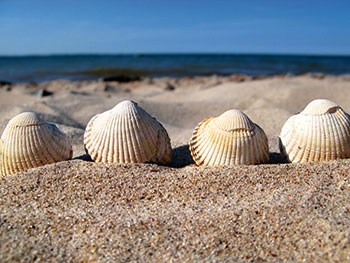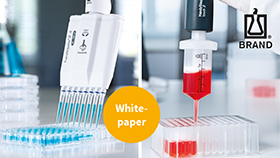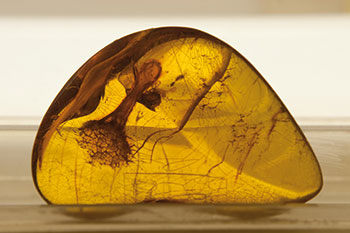Welcome to the Baltics
Career strategies for young European scientists
by Ralf Schreck, Labtimes 03/2011
The Baltic States are trying to boost science and education in times of empty coffers. Brain drain, fragmentation, small and over-aged scientific communities and poor infrastructure are major challenges. EU funds should now facilitate a great leap forward.
Science and education have a long-standing tradition in the Baltic States. Did you know that Nobel laureate Aaron Klug was born in Lithuania, that the Estonian embryologist Karl Ernst von Baer formulated the germ layer theory of development or that the native Latvians, Wilhelm Ostwald and Friedrich Zander, made substantial contributions to the invention of nitrate fertilisers and liquid-fuelled rockets? All have in common that they spent only part of their lives in their native countries. This also applies to today’s situation, where many promising scientists prefer to work abroad. Only two decades after regaining independence, the Baltics still have to find their own way of establishing and maintaining a competitive science and education system. Here, Lab Times is telling you what to expect, if you choose to do science off the beaten track.
Background
Estonia, Latvia and Lithuania are commonly known as the Baltic States. After World War I, the neighbouring countries in the north-eastern corner of Europe declared their independence from the Russian Empire and became sovereign nations. The Red Army occupied the Baltic territory again in 1940. The three countries were annexed as Soviet Socialistic Republics. The subsequent Sovietisation was accompanied by nationalisation, large-scale industrialisation and mass deportation of more than half a million Baltic nationals. At the same time, there was a large influx of industrial workers from other parts of the USSR. Nowadays, many of the remaining 1.1 million ethnic Russians in the Baltics still have only alien or non-citizen status. Peaceful efforts known as the Singing Revolution led to the restoration of independence in 1991 and included the Chain of Freedom, which was made up of two million people connecting the three Baltic capitals over a distance of 600 kilometres.
The transition from a planned towards a liberal market economy was initially slow. After referenda, the Baltic nations became members of the EU in 2004. Largely privatisation contributed to the boom period between the years 2000 and 2007, which was termed Baltic Tiger in reference to Asian countries experiencing a similar phase of rapid economic growth. All three countries were hit hard by the global financial crisis in 2008. Their gross domestic product slipped by more than 16% in 2009. Unemployment rates soared and are amongst the highest in the EU. Estonia, with a more stable economy and low public debt, seems to be recovering first and adopted the euro earlier this year. Latvia suffered most and requested a €7.5 billion loan package from the EU, the International Monetary Fund in 2008. The lenders imposed a harsh austerity policy. In the latest Global Competitiveness Report, Estonia was 33rd, Lithuania 47th and Latvia 70th among 139 evaluated countries.
Shortly after annexation, Soviet-type National Academy of Sciences displaced the former learned societies. Novel academy research institutes were established in part by incorporating public institutions. Scientific networks were formed, fulfilling the tasks of a Ministry of Science. After 1991, the whole research system was in urgent need of a makeover. This was, however, no top priority for the governments, who were more concerned with establishing new economical and social structures. The tasks of the national academies were re-defined. They continued to operate as expert bodies but their role as research performers was almost completely cut. Many of their institutes were transferred to universities. After becoming members of the EU, the Baltic countries had to adopt a more structured approach in order to receive financial aid and developed multi-annual national framework programmes for research and innovation. To advance their integration into the international scientific community, the Baltic States are actively participating in EU programmes, as well as in multi-national organisations and networks such as NordForsk, ScanBalt, European Science Foundation, EMBO and HFSP.
The recent economic crunch also had a major impact on science and education in the Baltics. The European University Association reported that Estonia and Lithuania reduced the funding of universities by up to a tenth each year since 2009, whereas Latvia’s cut was 50% in 2009 and an additional 18% last year. Salary and staff reductions, and the closure or merger of university departments and institutes are on the agenda. What keeps research and education alive are funds provided by the EU Regional Policy. Between 2007 and 2013, the Baltics are about to receive more than €3 billion earmarked for research, education and development. Nevertheless, limited resources, over-aged scientific communities and the exodus of primarily younger scientists have left their marks. For example, only two Baltic universities made it into the top four hundred in the QS World University Ranking in Life Sciences: the University of Tartu from Estonia and the Vilnius University from Lithuania. Scientific performance indicators are also at the bottom end. In the SCImago journal and country ranking, none of these three countries are listed among the top performers in Eastern Europe with respect to citations or impact of publications.
ESTONIA
Estonia has a total population of 1.34 million. Tallinn with 400,000 and Tartu with 100,000 people are the two largest cities. The official language, Estonian, is closely related to Finnish. Estonia is member in the EU, NATO and OECD. Economic ties are strong with Finland and Sweden, which receive more than 40% of exports and are responsible for 70% of foreign investments. Economic key sectors encompass information and telecommunication technology, electronics, transport and logistic services, industrial machinery and metal processing. Estonia is rated high in several rankings for simplicity of taxation, freedom of trade and innovative e-services and mobile communications. For example, the voice-over-internet application Skype was developed by Estonians and e-voting is offered at elections.
Biotech in Estonia is in a very early phase. According to the Estonian Biotech Strategy 2008-2013, there are about 50 biotech companies in Estonia. Many are spin-offs of universities and located at Tartu Science Park or at the Tallinn Technology Park Tehnopol. Companies offering diagnostic services or novel therapies against cancer and HIV stand out. Examples include Celecure developing anticancer drugs, ProtoBios exploiting early disease biomarkers, Asper Biotech focusing on human DNA analysis services, or Solis Biodyne providing PCR supplies.
The Estonian system
The current Estonian system was set by the 1997 Organization of Research and Development Act. The Government is in charge of research policies, which are submitted to the parliament as legal texts for approval. The major research advisory body is the Research and Development Council with members from ministries, academia and business. The Ministry of Education and Research is dominating the planning and coordination of research and education policies. The Ministry of Economic Affairs and Communications is responsible for innovation. Major funding sources are the Ministry of Education and Research itself, the Archimedes Foundation serving as a contact point for EU programmes, the Estonian Science Foundation providing competitive research grants, and Enterprise Estonia supporting entrepreneurship and public-private cooperation. Non-governmental expert bodies are the Estonian Academy of Sciences and the Estonian Rectors’ Conference.
Main goals of the strategy “Knowledge-based Estonia 2007-2013” are to improve the scientific quality and productivity, to increase the participation of the enterprise sector in research and innovation activities. Information and communication, biotech and new materials receive priority funding. The “Higher Education Strategy 2006-2015” introduces, amongst others, new programmes for incoming and outgoing mobility. The “Estonian Research Infrastructure Roadmap” aims to refurbish old buildings and replace worn out equipment as well as to secure participation in international programmes. In biology and medicine, the establishment of the Estonian Centre for Genomics, the National Centre for Translational and Clinical Research and the Estonian PET-Centre for advanced medical imaging is envisaged. According to Statistics Estonia, the 2009 expenditure for Research and Development (R&D) was 1.42% of the gross domestic product or about €200 million, a 5% cut in comparison to the previous year. Half of the R&D expenses were from public sources, two fifths from the private sector. As already mentioned, Estonia is currently receiving EU funds, out of which €0.8 billion are budgeted for R&D.
Estonian research performers
Public universities are the main research performers in Estonia and engaged primarily in basic research. Universities consist of faculties and research institutes. In addition, there are two types of state-owned research establishments. One is focusing on specific topics, such as the Estonian Biocentre, the National Institute for Health Development and Cardiology Institute or the Jõgeva Plant Breeding Institute. The other is more independent, such as the National Institute of Chemical Physics and Biophysics at Tallinn, which performs basic and applied research in material sciences, biotechnology and computer science. Two major excellence programmes are in place. There are seven Centres of Excellence, including the Centre of Excellence in Genomics at the Estonian Biocentre or the Centre for Integrated Electronic Systems and Biomedical Engineering at Tallinn. The Competence Centre Programme was set up to stir cooperation between universities and enterprises. There are currently eight centres focussing, for example, on reproductive medicine and biology, cancer or nanotechnology.
The higher education sector of Estonia encompasses 34 institutions, including six public and four private universities. Tartu University was founded in 1632 and is one of the oldest universities in Northern Europe. With 17,000 students, it is also the largest university, followed by the Tallinn University of Technology with 11,000, the Tallinn University with 8,000 and the Estonian University of Life Sciences with 4,500 students. Universities have substantial autonomy. Tuition fees vary from €1,000 to more than €7,000 per year. More than 100 degree programmes are taught in English. In non-English programmes you have to prove that you are able to follow the class. Higher education in Estonia follows the three cycles leading to Master, Bachelor and Doctorate within three, two and four years, respectively. A novel national quality assurance system will be introduced in 2012. Only 1.7% of the 68,000 students are not Estonians, whereas about 5,000 Estonians study abroad. A better financing, a doctoral school system and the employment of doctoral students as early stage scientists should now increase the attractiveness of postgraduate studies and lead to more than 300 new doctorates per year by 2013.
If you are interested in paying Estonia a visit, several opportunities are in place. The Ministry of Education and Research and the Archimedes Foundation have bilateral agreements with 20 countries listed under www.StudyinEstonia.ee. Funded is either a short-term visit for up to 21 days or a long-term stay between one and ten months, but not travel and tuition fees. You have to apply together with your foreign partner organisation. An invitation from your host is needed. Another opportunity for Master and PhD students as well as research staff from abroad is DoRa, the €32 million Doctoral Studies and Internationalization Programme managed by the Archimedes Foundation. Applications have to be made to the host university. For PhD students, two scholarships are available. Visiting scholarships cover a stay between one and ten months and are not restricted to a field of study. Degree-seeking PhD students are expected to enrol into an accredited doctoral programme. Scholarships are limited to six fields of study including biotech, health and materials technology. Provided are a monthly living allowance of €384, a round-trip to your home country, health insurance and a mobility allowance of €256 per month.
Estonian Science Foundation
The Estonian Science Foundation was established in 1990 as a funding agency and supports basic and applied research via competitive and peer-reviewed grants. Main objectives are to promote the best scientists, to involve more postgraduate and doctoral students in research and to increase international cooperation and mobility. The highest decision-making body is the Council headed by Toivo Maimets from the University of Tartu. The majority of the €14 million budget is used for up to four-year research grants. Each year, 2,700 scientists and students are involved in 600 funded projects. Applications have to be submitted electronically via ETIS, the Estonian Research Information System. There, you can also find a searchable database covering institutions, researchers or funded projects and additional details on science and research funding in Estonia.
ERMOS, MOBILITAS and My First Grant support early career scientists. ERMOS and MOBILITAS are targeting primarily postdocs and provide similar allowances: an annual pre-tax income of up to €25,600, a contribution to overhead costs, research-related costs up to €5,760 a year and a one-time mobility allowance of €6,500 for scientists changing countries. Funding is provided for up to three years. Forty-five new awards are made each year. According to Meelis Sirendi from ETF, up to half of applications received funding in the past but Estonia is now becoming more attractive for foreigners and application numbers are on the rise. ERMOS, the former Postdoctoral Research Grant programme, is co-funded by the 7th EU Framework Programme. Incoming postdocs, who received their doctorate not more than five years ago, may apply. There is one call per year around March. The €20 million mobility programme MOBILITAS, is funded primarily by EU Structural Funds. Supported are incoming and outgoing postdocs, but also scientists who want to set up a research group in Estonia. The next deadline is at the end of May. My First Grant targets advanced scientists, who earned their PhD during the last six years and have not received any standard grants, so far. My First Grant is quite popular and more than 100 young researchers apply each year. The success rate is up to 40% and the next deadline is scheduled for early May.
LATVIA
Half of the 2.2 million people of Latvia live in the greater Riga region. Riga is not only an UNESCO world heritage site but also the major economy, science and education centre of Latvia. The official language is Latvian and the currency is the Lats. Latvia was hit particularly hard by the global downturn. According to Eurostat, after Bulgaria and Romania, Latvia was the third poorest EU country in 2009. The Latvian pension system is on the verge of collapse; unemployment, which was 5.3% in 2007, exploded to more than 20% in early 2010. Tax increase, inflation, salary cuts and an inefficient crisis management provoked riots and led to the resignation of Prime Minister Ivars Godmanis in 2009. The introduction of the euro has been postponed.
Latvia’s economy is largely driven by the service sector, followed by industries and agriculture. The service sector is dominated by information and communication technologies, transport and logistics, and tourism. The industry sector is built on cheap labour and on manufacturing including wood, food processing and textiles. High-tech industries play no significant role. However, Latvia has a long tradition in the production of fine chemicals and pharmaceuticals. In the former USSR, Latvia was involved in the making of a quarter of all drugs. Nowadays, JSC Olainfarm and Grindex are the two largest Latvian pharma companies. There are about 25 biotech companies in operation, such as the lab equipment manufacturers Biosan and Elmi, the research service provider Asla Biotech and PharmIdea focusing on novel ways to combat cancer.
The Latvian system
The Law on Research Activity from 2005 and its amendments provide the framework for the Latvian research system. The law defines the roles of policy-making bodies, research performers and the main funding activities. The Ministry of Education and Science is the main developing and implementing structure of research policies, whereas innovation policies are taken care of by the Ministry of Economics. Funding instruments include institutional block funding to research institutions, four-year national research programmes, infrastructure measures and competitive research grants. Major advisory bodies are the Commission of Strategic Analysis, the National Development Council and the Latvian Academy of Sciences. At the operational level, there are the Latvian Council of Science, the State Education Development Agency and the Latvian Investment and Development Agency.
National priority areas include health, innovative materials and technologies as well as energy and environment. Valid documents are the National Strategic Reference Framework of Latvia 2007-2013, the Action Plan for Necessary Reforms in Higher Education and Science 2010-2012 and the Guidelines for Development of Science and Technology for 2009-2013. Whether the reforms are feasible remains uncertain, due to severe budget cuts and the delayed onset of EU programmes. From 2008 to 2009, Latvia’s total R&D funding dropped from €140 to €85 million and public R&D funding from €67 to €38 million. With an expenditure relating to 0.45 % of its gross domestic product, Latvia was together with Romania and Cyprus at the low end in Europe. Now, the gaps should be filled with more than €1 billion originating from the EU’s Regional Policy. Targets are the recruitment of 1,000 scientists, the provision of 1,600 PhD fellowships between €855 to €1,140 per month, the support of 200 national and 30 international research projects and the modernisation of 35 institutions. Up to five scientific institutions with international standing, up to nine national level research centres and 20 regional level institutions will receive priority funding. However, the implementation of the operational programmes is heavily delayed.
The Latvian Council of Science (LCS) is funding competitive research projects. Its declining budget was less than five million euros in 2010. Major tasks include coordination, evaluation and financing of research. Moreover, LCS, together with the Ministry of Education and Science, prepares the annual science budget and drafts science laws. The Council has five expert commissions, whose members are scientists and elected by scientists working in the respective field. Funding is provided for basic and applied research projects for individuals and collaborative teams. Individual projects receive up to €64,000, joint projects up to €280,000. In 2010, 152 individual and 11 joint research projects received funding, while measures for internationalisation were suspended. The overall success rate was 60% in 2009.
Latvian research performers
The official register of scientific institutions, which is kept at the Ministry of Education and Science, lists 137 scientific institutions, including institutes, higher education establishments and commercial companies. According to the Law on Scientific Activity, it needs at least five scientists with a doctoral title, with relevance for the performed research, to be listed as an institution. In 2009, about 3,600 scientists worked in the Latvian science sector: 70% in higher education, 20% in state research institutes and the rest in the private sector. More than half of PhD holders are above the age of 54 years. It is estimated that more than 1,500 Estonian scientists work abroad.
Major research performers in Latvia are the institutions of the higher education sector and their associated R&D institutes. The University of Latvia at Riga is the largest university with more than 20,500 students and is also host to most of the scientific institutes, including nine agencies, seven research institutes and three faculty institutes. Riga Technical University (15,700 students), Latvia University of Agriculture in Jelgava (6,900 students) and Riga Stradins University (4,660 students) are other main universities. In the last academic year, the number of students at higher education institutions was 113,000, including 2,150 PhD students. Only 1.5% of all students are from abroad. R&D intensive state institutes that draw attention are the Latvian Institute of Organic Synthesis with a focus on drug development and the Latvian BioMedical Research and Study Centre conducting basic as well as translational research in various areas of biomedicine.
Funding opportunities
If you look for Latvian funding opportunities, you may ascertain that the Mobility Portal page of Latvia contains a lot of out-of-date data. According to Arnis Kokorevics from the Latvian EURAXESS Service Centre, this is about to change. The updated EURAXESS site will be launched next month and will also include the new Foreign Researcher’s Guide to Latvia. The State Education Development Agency (VIAA) is offering Latvian scholarships for students and scientists at higher education institutions. Supported are studies, research and participation in summer schools. Currently, agreements with roughly 30 different countries have been made. Travel to and from Latvia is not reimbursed. The next deadline is in early May. In addition, VIAA administers a few scholarships funded by foreign countries. The activity “Attraction of Human Resources to Science”, which is primarily funded by the European Social Fund, wants to attract expatriates and foreign scientists to Latvia. For example, funding is provided for the establishment of international research teams working on interdisciplinary topics. In the first round, 35 out of 154 applications received between €0.2 to 2 million per project. Job openings form this measure and opportunities in frame of additional international agreements may be found at individual universities and research institutions.
LITHUANIA
Lithuania is the largest of the Baltic countries with a population of 3.2 million people. Vilnius with more than half-a-million, Kaunas with 380,000 and Klaipeda with 185,000 people are major cities. The main ethnic groups are the Lithuanians (83%), the Poles (6%) and the Russians (5%). The official language is Lithuanian and the currency is the Litas. The financial crisis reduced the gross domestic product by a fifth in 2009. The government launched a harsh austerity package. Unemployment jumped to 18% last year. But the economy is recovering with Russia, Germany, Poland and Latvia as main trading partners. Lithuania’s economy is driven by services (75%), industry (21%) and agriculture (4%). High-tech continues to gain importance. Lithuania, once known as the Soviet Silicon Valley, attracts foreign capital with its low corporate tax rate and one of the world’s best and speediest Internet systems. Financial service providers, such as Barclays Bank or Western Union, are outsourcing their operations to Lithuania. Many international companies have also made investments in the information and communication technology sector. IBM just signed a deal with the Lithuanian government to establish a new research centre on nanotechnologies, with the aim of developing parts for ultra-fast computers. Lithuania operates ten science and technology parks, mainly located at Vilnius and Kaunas, which provide infrastructure for enterprises.
Laser technology and biotech are additional high-tech pillars. Every tenth laser used in the world was made in Lithuania. About 15 Lithuania-based companies dominate the market in ultra-fast and high-energy lasers. Success stories from Lithuania’s biotech sector are Fermentas and Sicor Biotech. In 1994, both companies separated from the Institute of Biotechnology, a state research institute. Fermentas became quite popular for its large and reasonable repertoire of restriction enzymes and rapidly expanded its international operations. Nowadays, it offers a wide range of tools for life science research and diagnostics. In 2010, the US company Thermo Fisher Scientific acquired Fermentas for US$ 260 million. Sicor Biotech is producing recombinant proteins for medical use, such as interferons or growth hormones. In 2004, it became member to Teva Pharmaceuticals Industries. Biotech is further strengthened by national biotech programmes and by the EU project “Strengthening and Sustaining the European Perspectives of Molecular Biotechnology in Lithuania” (MoBiLi).
The Lithuanian System
R&D expenditure in 2009 was €220 million or 0.84% of the gross domestic product. More than half was disbursed in the higher education sector, the rest evenly distributed between the governmental and enterprise sector. The elections in 2008 led to a new government, which introduced policy changes pointing out research and innovation as future drivers of Lithuania’s economy. The new Law on Higher Education and Research was finally passed in 2009 and introduced far-reaching reforms, many of which are still in the implementation phase. The law introduced new elements of competition, financing and external evaluation strengthened the autonomy of universities, and the status of colleges and substantially improved the student loan system. The overall number of higher education sector institutions and research institutes is about to be reduced. Funding priorities are placed on high-tech areas such as biotech and biomedicine, natural resources and agriculture, new materials, physical and chemical technologies and information technology. Current strategies are laid down in the Lithuanian long-term Science, Research and Development Strategy 2015, the Lithuanian High Tech Development Programme (2007-13) and the Development of the Lithuanian Higher Education System (2007-12). They have been developed in line with the EU Structural Funds Implementation Strategy for the period 2007-2013. The EU Structural Funds Programme will provide €180 million for a Researchers Career Programme, €220 million each for a Higher Education Programme and €100 million for competitive National Science Programmes.
The reforms also led to structural changes. The Lithuanian Science Council was transformed into the Lithuanian Research Council (LRC) in late 2009. Its main tasks are to advise the Seimas (parliament) and the government on issues related to research and training of scientists, to participate in the implementation of competitive funding measures, including mobility programmes and to establish evaluation procedures. Main bodies of the LRC are the six-member board, two ten-member expert committees, which form the Committee of Humanities and Social Sciences and the Committee of Natural and Technical Sciences, and the Research Foundation implementing funding decisions made by the Council. Moreover, the Agency for Science, Innovation and Technology was re-structured to promote innovation activities at the national and international level, to foster public-private cooperation and to act as funding agency for assigned programmes.
Lithuanian research performers
There are 14 public and eight private universities, as well as 13 public and ten private colleges in Lithuania. There were also previously about 45 research institutes, listed either as university research institute, state research institute or state research institution. Now, the overall number of state research institutes will be restricted to six and 17 research institutes that will be integrated into universities. Five Integrated Centres of Science and Research and five Integrated Science, Study and Business Centres (Valleys) have already been established or are in the implementation phase. Science Centres in Vilnius include the Centre of Innovative Medicine, the Nature Research Centre and the Centre for Physical Sciences and Technology. Valleys, supported by hundreds and millions of euros, create the necessary infrastructure to perform competitive science and promote public-private cooperation. At Vilnius, Sunrise Valley will focus on laser and nanotechnologies and new materials, whereas Santara Valley concentrates on molecular medicine, biotechnology and information and communication technology. At Kaunas, Santaka Valley will deal with bio-pharmacy and health technologies, whereas Nemunas Valley is devoted to agro-biotech, bioenergy and food technology. At Klaipeda, the Maritime Valley covers marine technologies.
In the last academic year, more than 130,000 students were enrolled, including 2,700 doctoral students. The level of foreign students was around 2.5%. Vilnius University was established in 1579 and is the oldest; with more than 22,000 students it is also the largest university of the Baltic countries. The Kaunas University of Technology with close to 17,000 students is the largest technical university of the Baltics and the 2nd largest university in Lithuania. Staff members are initially employed for five years. After this time, they have to participate in an open competition. After winning two competitions, they receive a permanent contract. However, their performance is evaluated every five years and scientists failing are dismissed. Research staff is categorised as Chief Research, Senior Research, Research and Junior Research staff member. Postdoctoral appointments are limited to two years with the possibility of a one-year extension. Visiting staff members are employed by a fixed-duration employment contract for a period not exceeding two years.
Funding opportunities
The Research Council of Lithuania is in charge of the three major Lithuanian mobility programmes: short-term visits, two-year postdoc fellowships, and up to four-year research projects in the Global Grant scheme. All are financed to a great extent by EU money. Short-term visits between four and 50 days are provided for incoming foreign or outgoing domestic scientists. Daily pay is €116 plus part of travel as well as research expenses up to €23 per day. Two-year postdoc fellowships are for scientists with a doctoral title awarded within the last five years. They come along with an annual salary of up to €14,200, a salary add-on of €1,230 for your supervisor, a mobility allowance of €4,060 and €2,230 for direct and indirect research expenses. You have to apply together with the host institution and a recognised scientist, who functions as your research supervisor and collaborator. A research stay in a foreign lab of at least two months is mandatory. You may register on a list for scientists looking for a research supervisor under www.postdoc.lt.
The Global Grant scheme promotes excellent 24 to 48-month research projects conducted by Lithuanian or foreign researchers at Lithuanian institutions. Up to €464,000 will be made available per project and 200 projects shall receive funding up until 2015. Young researchers, who obtained a degree between three and seven years ago, and experienced researchers with no less than seven years of research experience, may apply together with the host institution. Young researchers have to prove their excellence with at least ten pieces of evidence, including publications listed in the ISI Web of Science or patents. The experienced researcher has to submit at least 25 proofs gathered since 1995. According to Eglė Vaitkutė from the Research Council of Lithuania, 33 out of 173 applications with an average funding of €0.3 million per project were granted in the first round. One ex-pat and two non-Lithuanian scientists were among the awardees. The next call will be published later this year. Additional opportunities are provided by the Education Exchange Support Foundation, which was established in 2007 as national agency for the Lifelong Learning Programme, plus a number of additional EU and national programmes within the field of education and training. There you might also get more information on bi-national agreements fostering mobility.
OUTLOOK
Economic and political stability seem to be major prerequisites for sustainable reforms in the Baltic countries. Billions from Brussels are currently used to improve research infrastructure and human resources. Research topics have been prioritised and steps towards a knowledge-based economy have been made. However, it may take a couple of years before these efforts bear any fruits. For the individual scientist, it would be very desirable to make a decent living from one salary, so that he is able to focus on his research and not be dependent on additional jobs or salary add-ons from research grants. With a modernised infrastructure, improved working conditions and real career perspectives, scientists will refrain from leaving for good. Expatriates and the foreign research talent will consider the Baltics as an option. A couple of advanced institutions in the Baltic States have been introduced above. It is down to you to have a closer look and draw your own conclusions.
Internet Resources
Estonia
Latvia
Lithuania
Last Changed: 09.06.2012











